
Swabia is one of the seven administrative regions of Bavaria, Germany. It consists of ten districts and 340 municipalities.
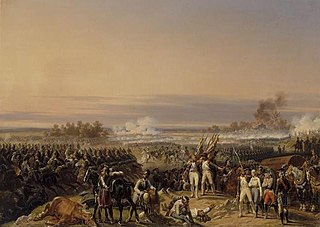
The Battle of Höchstädt was fought on 19 June 1800 on the north bank of the Danube near Höchstädt, and resulted in a French victory under General Jean Victor Marie Moreau against the Austrians under Baron Pál Kray. The Austrians were subsequently forced back into the fortress town of Ulm. Instead of attacking the heavily fortified, walled city, which would result in massive losses of personnel and time, Moreau dislodged Kray's supporting forces defending the Danube passage further east. As a line of retreat eastward disappeared, Kray quickly abandoned Ulm, and withdrew into Bavaria. This opened the Danube pathway toward Vienna.
Aichach-Friedberg is a Landkreis (district) in Bavaria, Germany. It is bounded by the districts of Augsburg, Donau-Ries, Neuburg-Schrobenhausen, Pfaffenhofen, Dachau, Fürstenfeldbruck and Landsberg, as well as by the city of Augsburg.
Dillingen is a Landkreis (district) in Swabia, Bavaria, Germany. It is bounded by the districts of Donau-Ries, Augsburg and Günzburg, and by the state of Baden-Württemberg.
Donau-Ries (Danube-Ries) is a Landkreis (district) in Swabia, Bavaria, Germany. It is bounded by the districts of Ansbach, Weißenburg-Gunzenhausen, Eichstätt, Neuburg-Schrobenhausen, Aichach-Friedberg, Augsburg and Dillingen, and by the state of Baden-Württemberg.
Günzburg is a Landkreis (district) in Swabia, Bavaria, Germany. Its capital is the town Günzburg. It is bounded by the districts of Dillingen, Augsburg, Unterallgäu and Neu-Ulm, and by the state of Baden-Württemberg.

Blindheim, traditionally known in English as Blenheim, is a village and a municipality in the Bavarian district of Dillingen in southern Germany. It is north of Augsburg, on the left bank of the Danube River.

Donauwörth is a town and the capital of the Donau-Ries district in Swabia, Bavaria, Germany. It is said to have been founded by two fishermen where the rivers Danube (Donau) and Wörnitz meet. The city is part of the scenic route called "Romantische Straße".
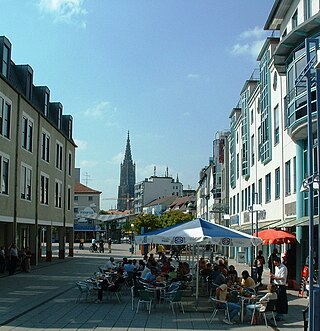
Neu-Ulm is the seat of the Neu-Ulm district and a town in Swabia, Bavaria. Neighbouring towns include Ulm, Senden, Pfaffenhofen an der Roth, Holzheim, Nersingen and Elchingen. The population is 58,978.
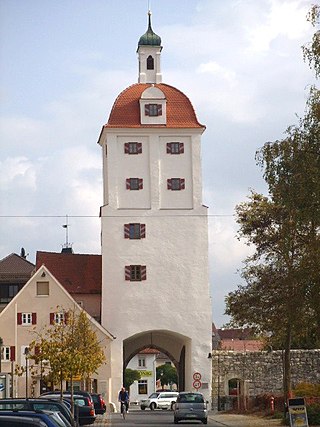
Gundelfingen an der Donau is a town in the Bavarian district Dillingen in Swabia. Gundelfingen is located at the river Danube (Donau), between Stuttgart, Munich and Augsburg. It has some 8,000 inhabitants and still resembles the town of the Middle Ages. The town is the seat of the municipal association Gundelfingen an der Donau, which includes the towns Bächingen, Haunsheim and Medlingen.

Neuburg an der Donau is a town which is the capital of the Neuburg-Schrobenhausen district in the state of Bavaria in Germany.

Lauingen is a town in the district of Dillingen in Bavaria, Germany. It is located on the left bank of the Danube, 5 km west of Dillingen, and 37 km northeast of Ulm.

Leipheim is a town in the district of Günzburg, in Bavaria, Germany. It is situated on the Danube, 5 kilometres west of Günzburg, and 17 kilometres northeast of Ulm. The village Riedheim and the hamlet Weissingen are districts of Leipheim. Since 1993, Leipheim has been twinned with the Hungarian town Fonyód.

Rain is a town in the Donau-Ries district, in Bavaria, Germany. It is situated on the river Lech, close to its confluence with the Danube, 11 km east of Donauwörth.

Johann Michael Sailer was a German Jesuit theologian and philosopher, and Bishop of Regensburg. Sailer was a major contributor to the Catholic Enlightenment.
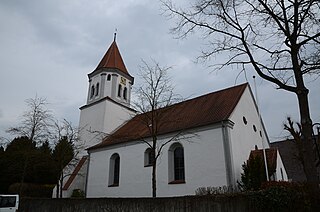
Bächingen is a municipality in the district of Dillingen in Bavaria in Germany. The town is a member of the municipal association Gundelfingen an der Donau.
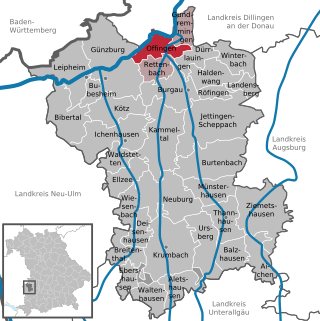
Offingen is a municipality in the Swabian administrative district Günzburg in Bavaria in Germany.

Kirchheim or Kirchheim in Schwaben is a municipality and a market town in the district of Unterallgäu in the region of Swabia (Schwaben) in the south-west of Bavaria, Germany. The town was greatly influenced by the Fugger family. North-east of the town lies the Augsburg Western Woods Nature Park.
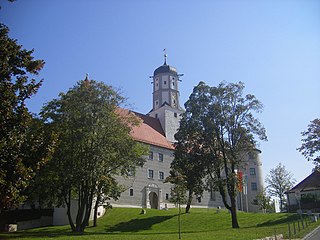
Höchstädt an der Donau is a town in the district of Dillingen, Bavaria, Germany. It is situated near the banks of the Danube. It consists of the following suburbs: Höchstädt an der Donau, Deisenhofen, Oberglauheim, Schwennenbach and Sonderheim. The town is the seat of the municipal association Höchstädt an der Donau, which includes the towns Blindheim, Finningen, Lutzingen and Schwenningen.
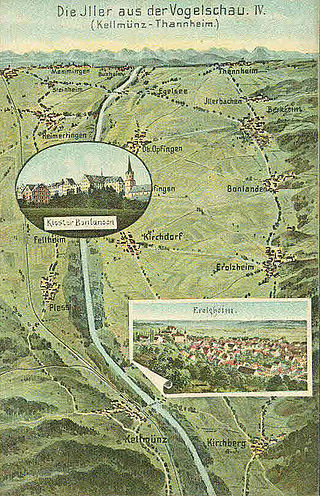
The Battle of Iller River or Battle of Erolzheim saw a French Republican army led by Jean Victor Marie Moreau fight a Habsburg Austrian army led by Paul Kray. In late May, the adversaries reached a stalemate with the Austrian army holding Ulm and the French army facing it from the south. Both armies numbered about 80,000 men. Kray launched an attack against the French left wing along the Iller River at Erolzheim and Illertissen, but he withdrew his troops when Moreau sent reinforcements. The action occurred during the War of the Second Coalition, part of the French Revolutionary Wars.























